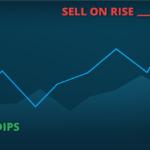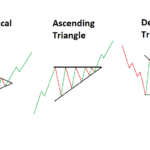Somewhere between the “buy & hold” traditions of hedgeTo protect one’s investments against losses by investing simultaneously in a (usually) related ins... fund giants such as Warren Buffet and the “day-tradingThe practice of opening and closing positions on the same day, primarily used by speculators.” techniques of Ross Cameron and Nick Leeson lie swing trades – a strategy whereby an assetA stock, commodity, currency, index or any other entity one may trade or invest in. is held for at least a day in hopes of profits based on the price differentials between opening and closing values.
One important advantage over day tradingPratique de trading consistant à ouvrir et à fermer des positions le même jour et principalement ... is that, since over a longer time period we are also looking at a larger price differential, covering the spreadThe variance between the quoted buy and sell price of an asset. In forex it represents the moneychan... here is less of a factor, and one can quite easily forego higher leverageAn investment provided by a broker or other provider alongside an investor’s investment, enabling ... levels that amplify by necessity the minuscule differentials targeted by the day traderA merchant who purchases and sells assets or services for profit. In financial markets, the trader b....
This is especially important for new traders who suddenly find their accounts depleted without understanding the difference between used, required and free margin, why these change all the time and so erratically.
An additional advantage for the beginner is the fact that one need not devote his/her entire day to cramming charts. The swing trader need not be so dedicated – he/she can afford to maintain his/her day job, checking back from time to time, but certainly not living by the candles.
Novice traders especially like swing trading because, while taking cues from or confirming a technical setup using the fundamentals, it relies heavily on simplistic technical tools, allowing the beginner to get his/her feet wet in a not-too-stressful manner, applying more and more indicators as he/she feels fit at a rate that enables one to examine the proceedings without missing the ‘cues’.
What is Swing Trading

Swing trading is called that because traders aim to monetise the swings between optimism and pessimism, as described in various forms of wave theory. As we know, these oscillations exist on various time-scales.
As described by Ralph Nelson Elliott, these are the Grand Supercycle, which spans over centuries, the Supercycle which spans over several decades, the Cycle for several years, the Primary Cycle that counts in months, the Intermediate cycle between months and weeks, the Minor for weeks, Minute for days, the Minuette cycle for hours and the Subminuette for cycles that span less than minutes.
Within these cycles, the same pattern repeats itself as a form of fractals.
As mentioned, the swing trader focuses on intermediate, minor and minute cycles.
Because most currencyA financial medium for the exchange of value. In economics, it is the monetary system employed by a ... pairs and commodities are subject to the daily news cycle, most swing traders will avoid dealing in these assets. Even index futures often react to an overall mood that is subject to the news. However, since stocks take longer to react en-masse to an external stimulant, the shorter-term swing traders will fin them in their portfolio.
The classic asset class for swing traders is – therefore – equities, which are subject to longer-term fundamentals and only then to changing sectoral factors. Here, the oscillations between optimism and pessimism will take anything from a day (following a major announcement) to several weeks (internal fundamentals).
Clearly, in the midst of a bear or bull marketA market for an asset whose value is increasing., one will trade the trend but be less involved than – say – with cash instruments. But generally speaking, a swing trader will much prefer stable and calm markets, where the oscillations are gradual but enduring.
Swing Trading Strategies

In order to prevent subjective emotional trading, swing trading relies heavily on technical tools and the use of algorithms and trading bots (primarily MQL derived Expert Advisers).
Unfortunately, with the prevalence of these, the bite of any individual trader in the general profits becomes smaller. However, because the positionAn open trade or transaction. A position can be long (a contract to buy the asset) or short (a contr... lengths are longer, swing traders will take more notice of fundamentals, especially regarding equities, where these take longer to express themselves.
A simplistic approach to technical swing trading involves the use of 3 different moving averages – most often 9, 13 and 50-day exponential moving averages – and trading a trend when all three conform. EMA crossovers are taken as entry, and exit signals, with a reversal indicated when the price line itself crosses respectively above or below the EMAs.
Of the 9dEMA crosses above the 13 dEMA, an entry for a long positionA position that is profitable (in the money) if an asset’s value rises. (or exiting a short) is implied so long as the latter remains above the 50 dEMA. If the 13 dEMA is below the 50 dEMA and the 9 dEMA crosses below the former, a one should either exit a long position or enter a short.
In all cases, be on the lookout for those classic patterns (head-&-shoulders, double/triple tops/bottoms, reversal candlestick patterns and so forth.
Luckily, entry and exit points at such time intervals become less critical, and for the trader willing to make several small profits rather than fewer large ones, swing trading can be both rewarding and fascinating – without requiring the mental stamina required for scalpingOpening and closing positions rapidly with the intention of locking in small profits., for example.
Controlling Risk
Swing trading enables the calm and collected planning of where to place stop loss and take profit orders, as based in risk-reward ratios. Thus, for example, a beginner who seeks a 1:2 riskThe level of deviation of past returns and/or losses on an asset from the mean. Usually, the higher .../reward ratio will seek $2 profit on every $1 he/she risks losing (although 1:3 probably makes more sense).
Traders, though, should always take into consideration off-time trading risks, such as gaps and abrupt reversals (the latter which are usually reinforced by the fundamentals, so ignore the news at your own risk).
But no matter what you do, at the end of the day, successful swing trading relies on the technical, and under no circumstances should you attempt to outsmart/outguess or second guess the marketA location or entity where people and entities can negotiate and trade assets of value..
Remember, technical trading abides thanks to Dow’s first law: The Market Discounts Everything. Asset prices incorporate all available information and reflect the reactions of all players to the fundamentals in concert. If you think you are outthinking a mass of individuals who instinctively feel, fear and thirst for the same things you do, you’re probably headed for a trading error of one sort or another.
Stop, think and get back to the trend before it’s too late.
In short
When I was a young(er) man, people kept asking me why I don’t devote my life to becoming a pianist, rather than simply “faking it”. I knew that were I to do so, what was for me pure enjoyment would become “a job”. If you love the excitement of financial markets, the appreciation of how the macro interacts with the micro and both with the day’s events, swing trading is the perfect solution to enjoying the mood swings without becoming bi-polar.











